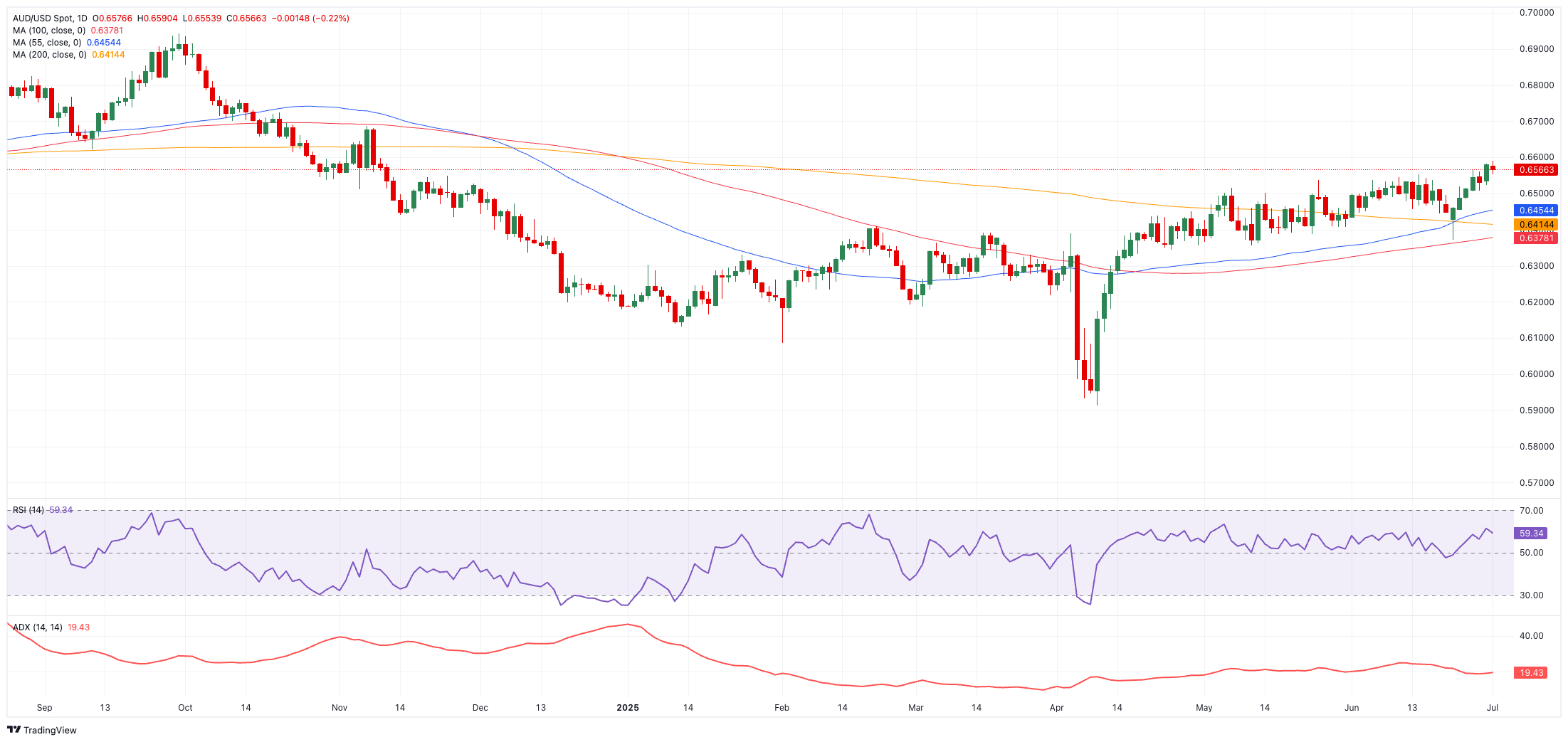
- AUD/USD rose to new 2025 peaks around 0.6590 before deflating.
- The US Dollar regained some upside impulse following multi-year troughs.
- Australia’s final S&P Global Manufacturing PMI came in at 50.6 in June.
The Australian Dollar (AUD) advanced to new yearly peaks vs. the US Dollar on Tuesday, although that initial move faded as the day progressed.
Indeed, AUD/USD rose to the vicinity of the 0.6600 hurdle on Tuesday, just to surrender part of those gains in response to a mild bounce in the Greenback.
The move continued to be underpinned by a recent and quite convincing break above the pair’s 200-day simple moving average (SMA) around 0.6420, a technical milestone that has brightened near-term sentiment toward the currency.
Domestic backdrop: Inflation tamed, activity solid
May’s monthly consumer price index eased to 2.1% from 2.4% in April, neatly inside the Reserve Bank of Australia’s (RBA) 2%–3% target band.
Additionally, the final readings from the S&P Global PMI indicated that the Australian manufacturing sector is still in the expansion territory (above 50).
China: Momentum vs. headwinds
According to the latest data, Australia’s largest trading partner painted a mixed picture.
Indeed, industrial output, retail sales, and broader services all accelerated in May, reviving the idea that the economy would expand around the annualised 5% milestone.
Monday’s NBS data saw the Manufacturing PMI and the Non-Manufacturing PMI improving marginally in June to 49.7 and 50.5, respectively. Adding to the vibe, Tuesday’s Caixin Manufacturing PMI rose to 50.4 last month.
Yet property-sector strains and a gradual withdrawal of stimulus threaten to sap that momentum until late 2025.
From the PboC, the central bank held its 1-Year and 5-Year Loan Prime Rates (LPR) at 3.00% and 3.50%, respectively, while funnelling CNY 300 billion into banks through a 1-Year medium-term lending facility (MLF) in late June.
Diverging central-bank paths
At home, the Reserve Bank of Australia (RBA) trimmed its cash rate by 25 basis points to 3.85% last month, signalling a measured glide path toward 3.20% by 2027 and rebuffing calls for a deeper “insurance” cut.
The Federal Reserve (Fed), meanwhile, kept policy steady but maintained guidance for two half-point reductions before year-end. Chair Jerome Powell cautioned that tariffs could reignite goods inflation over the summer.
Shifting market positioning
The latest CFTC data show speculators adding to their already bearish bets on the Aussie. Net shorts increased to nearly 96K contracts as of 24 June, the highest tally since April, while open interest rose to its highest in two weeks, just over 151K contracts.
Chart levels to watch
Key resistance sits first at 0.6590, the 2025 high (June 30), followed by the November 2024 top at 0.6687 (November 7), and the 2024 ceiling of 0.6942, before the psychologically important 0.7000 barrier.
On the downside, initial support is expected at the 200-day SMA at 0.6419, then the June trough at 0.6372 (June 23), and the May low of 0.6356 (May 12). A deeper slide would bring the 0.6000 milestone into focus ahead of the 2025 bottom at 0.5913 (April 9).
The technical backdrop remains constructive: the Relative Strength Index (RSI) hovers around 60, hinting at further upside momentum, while the Average Directional Index (ADX) near 22 still signals a moderately firm trend.
AUD/USD daily chart

Short-term outlook
AUD/USD seems to have broken above its multi-week consolidation band. Beijing’s policy mix and any surprise shift in US trade settings are the most obvious swing factors, though neither looks imminent. Markets are already bracing for another modest RBA cut later this year, but expect the bank to move cautiously rather than embark on an aggressive easing cycle.
Bottom line: barring a shock from abroad, the Aussie’s constructive stance looks set to hold in the short term, with incremental gains favoured as long as it stays north of its 200-day SMA.
Australian Dollar FAQs
One of the most significant factors for the Australian Dollar (AUD) is the level of interest rates set by the Reserve Bank of Australia (RBA). Because Australia is a resource-rich country another key driver is the price of its biggest export, Iron Ore. The health of the Chinese economy, its largest trading partner, is a factor, as well as inflation in Australia, its growth rate and Trade Balance. Market sentiment – whether investors are taking on more risky assets (risk-on) or seeking safe-havens (risk-off) – is also a factor, with risk-on positive for AUD.
The Reserve Bank of Australia (RBA) influences the Australian Dollar (AUD) by setting the level of interest rates that Australian banks can lend to each other. This influences the level of interest rates in the economy as a whole. The main goal of the RBA is to maintain a stable inflation rate of 2-3% by adjusting interest rates up or down. Relatively high interest rates compared to other major central banks support the AUD, and the opposite for relatively low. The RBA can also use quantitative easing and tightening to influence credit conditions, with the former AUD-negative and the latter AUD-positive.
China is Australia’s largest trading partner so the health of the Chinese economy is a major influence on the value of the Australian Dollar (AUD). When the Chinese economy is doing well it purchases more raw materials, goods and services from Australia, lifting demand for the AUD, and pushing up its value. The opposite is the case when the Chinese economy is not growing as fast as expected. Positive or negative surprises in Chinese growth data, therefore, often have a direct impact on the Australian Dollar and its pairs.
Iron Ore is Australia’s largest export, accounting for $118 billion a year according to data from 2021, with China as its primary destination. The price of Iron Ore, therefore, can be a driver of the Australian Dollar. Generally, if the price of Iron Ore rises, AUD also goes up, as aggregate demand for the currency increases. The opposite is the case if the price of Iron Ore falls. Higher Iron Ore prices also tend to result in a greater likelihood of a positive Trade Balance for Australia, which is also positive of the AUD.
The Trade Balance, which is the difference between what a country earns from its exports versus what it pays for its imports, is another factor that can influence the value of the Australian Dollar. If Australia produces highly sought after exports, then its currency will gain in value purely from the surplus demand created from foreign buyers seeking to purchase its exports versus what it spends to purchase imports. Therefore, a positive net Trade Balance strengthens the AUD, with the opposite effect if the Trade Balance is negative.
Information on these pages contains forward-looking statements that involve risks and uncertainties. Markets and instruments profiled on this page are for informational purposes only and should not in any way come across as a recommendation to buy or sell in these assets. You should do your own thorough research before making any investment decisions. FXStreet does not in any way guarantee that this information is free from mistakes, errors, or material misstatements. It also does not guarantee that this information is of a timely nature. Investing in Open Markets involves a great deal of risk, including the loss of all or a portion of your investment, as well as emotional distress. All risks, losses and costs associated with investing, including total loss of principal, are your responsibility. The views and opinions expressed in this article are those of the authors and do not necessarily reflect the official policy or position of FXStreet nor its advertisers. The author will not be held responsible for information that is found at the end of links posted on this page.
If not otherwise explicitly mentioned in the body of the article, at the time of writing, the author has no position in any stock mentioned in this article and no business relationship with any company mentioned. The author has not received compensation for writing this article, other than from FXStreet.
FXStreet and the author do not provide personalized recommendations. The author makes no representations as to the accuracy, completeness, or suitability of this information. FXStreet and the author will not be liable for any errors, omissions or any losses, injuries or damages arising from this information and its display or use. Errors and omissions excepted.
The author and FXStreet are not registered investment advisors and nothing in this article is intended to be investment advice.








